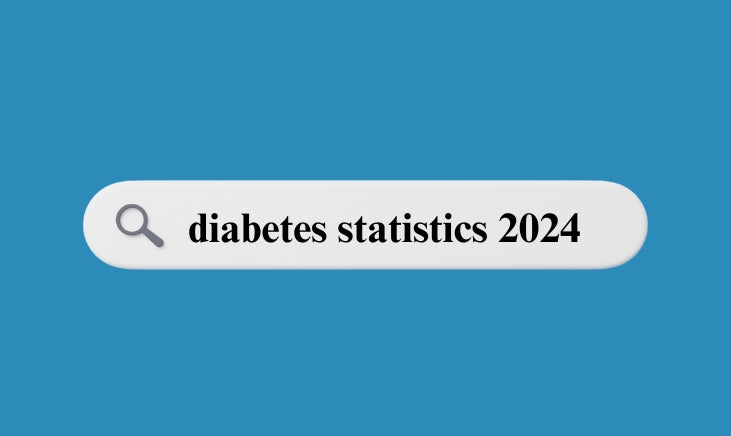Menu
Your cart is empty
Looks like you haven't added anything to your cart yet

Diabetes Statistics: Where Do We Stand in 2024?
Diabetes Statistics
In the realm of public health, understanding the current landscape of diabetes is crucial, as it mirrors the overall health of the population. Diabetes, primarily classified into two types – type 1 (T1D) and type 2 (T2D) – affects millions globally, with over 90% of cases being T2D.
While T2D is largely preventable and manageable through lifestyle adjustments, T1D is an autoimmune disorder not influenced by diet or lifestyle, and its exact causes remain partially elusive to scientists. In Type 1 Diabetes, the pancreas doesn’t make insulin to regulate blood sugar. T2D results from insulin resistance, meaning it doesn’t make enough. Managing both types involves a critical emphasis on blood glucose level monitoring through diet and testing.
Unchecked, diabetes can have severe consequences, including blindness and limb loss. Recent years have seen evolving diabetes statistics, necessitating a vigilant eye from experts to adapt healthcare strategies and understand the shifting trends in this chronic disease landscape.
Overview of Diabetes in 2024
Quick Stats:
- 10.5% of adults worldwide have diabetes
- 90% of cases are type 2 diabetes
- Over 4 million deaths a year are attributed to diabetes
Global Diabetes Statistics

Source: International Diabetes Federation
As we step into 2024, the global statistics on diabetes present a critical overview of the disease's prevalence and its escalating impact. According to the latest data from the International Diabetes Federation, approximately 10.5% of the adult population worldwide is living with diabetes, alarmingly with nearly half of them unaware of their condition.
This prevalence marks a significant rise in Type 2 Diabetes, which is projected to alarmingly swell to 643 million individuals by 2030, and potentially double to 1.3 billion by 2050 if current trends persist. The Lancet's global burden of disease study, spanning data from 1990 to 2021, further underscores this escalating trajectory.
Highlighting geographical disparities, regions like North Africa and the Middle East, along with other low and middle-income countries (LMICs), are identified as high-risk areas. Countries with the highest rates of diabetes in 2021 were China, India, and Pakistan.
The surge in these regions is primarily attributed to rapid urbanization and development, impacting lifestyle and health such as more processed food and fast food chains making their way to these regions and more people working sedentary corporate jobs as nations develop.
Diabetes Statistics in the United States
Quick Stats:
- In 2021, the US had the fourth-highest rate of diabetes incidence after Pakistan
- Diabetes is the eighth leading cause of death in the US
- 11.6% of the US population has diabetes
In the United States, the situation is monitored by several organizations, including the National Institute of Health (NIH), the American Diabetes Association (ADA), and the Centers for Disease Control and Prevention (CDC), which regularly releases reports based on the Behavioral Risk Factor Surveillance System (BRFSS) survey.
The National Diabetes Report states that an estimated 38.4 million people have diabetes, making up 11.6% of the US population. There are approximately 28,000 children and young people aged 20 or younger who have Type 2 Diabetes. Type 1 is still more prevalent in this age group at 185,000, but T2D is on the rise in youth.
These statistics not only indicate the current state of diabetes globally but also serve as a stark reminder of the urgent need for effective management strategies and healthcare interventions to combat this growing epidemic.
Impact of Lifestyle and Environment

The prevalence of diabetes is profoundly influenced by lifestyle choices and environmental factors, making them critical areas of focus in combating the disease. Sedentary lifestyles, coupled with diets rich in processed foods and lacking in whole, nutrient-dense options, have become a primary driver of diabetes rates.
These days most people are aware of what drives obesity and that eating healthy and exercising is how to effectively manage weight. However, it’s not that simple. There are a myriad of other factors and privileges that go into how healthy someone is able to live.
The concept of an "obesogenic environment" is increasingly relevant, especially in parts of the United States where people face challenges like lack of access to affordable, healthy food, un-walkable cities and towns, and long driving commutes, all contributing to a sedentary way of life. Regions such as the rural and southeastern regions of the US often grapple with food swamps and food deserts, leading to higher obesity and diabetes statistics.

In response, preventive measures and public health campaigns are more vital than ever. These include regular screening for diabetes and prediabetes, which involves checking blood glucose levels.
Public health observances like World Diabetes Day help raise awareness, while lifestyle recommendations by public health initiatives and departments encourage maintaining a healthy body weight, staying physically active, avoiding excessive sugar and saturated fat, and refraining from smoking.
Some public health campaigns aimed at controlling the diabetes epidemic are:
- World Diabetes Day: November 14th each year to raise awareness about diabetes prevention and management
- Do I have prediabetes?: A collaboration between the CDC and the American Medical Association involving screening for diabetes and prediabetes which involves blood glucose screenings
- Diabetes Self Management Education and Support (DSMES): Education and support for people managing diabetes through the CDC
- Healthy People 2030: A set of data-driven goals and objectives by the US Department of Health and Human Services to be accomplished by 2030
- Individual states and local public health departments will have their own unique diabetes programs and initiatives.
Diabetes in Different Age Groups and Demographics
Quick Stats
- 1 in 5 youth aged 12-18 has prediabetes
- Diabetes prevalence is similar in men and women
- A greater percentage of American Indians have diabetes compared to other racial groups
Age
The landscape of diabetes is changing dramatically across various age groups and demographics, reflecting broader societal and health shifts. Historically, diabetes, particularly type 2, was predominantly a concern for older adults. However, recent trends paint a different picture; rising obesity rates have now made type 2 diabetes a growing concern among youth.
Alarmingly, data from the CDC indicates that one in five kids aged 12-18 is now diagnosed with prediabetes, setting them on a trajectory towards developing type 2 diabetes. Prediabetes is when an individual has a blood sugar level higher than normal but isn’t high enough to be classified as diabetes.
Gender
When it comes to gender-specific trends, diabetes is on the rise in both men and women. Men tend to be diagnosed earlier and at a lower BMI compared to women, suggesting differences in how the disease manifests and is detected across genders.
Additionally, women face the specific challenge of gestational diabetes (diabetes during pregnancy), with about 50% of those affected during pregnancy going on to develop type 2 diabetes later.
Race
Racial and ethnic disparities also play a significant role in diabetes prevalence. Certain groups, particularly American Indian and Alaska Natives, Black, and Hispanic populations, are disproportionately affected. These disparities are further compounded by socioeconomic factors, with those in lower socio-economic brackets facing higher risks, likely due to factors like access to healthcare, nutritional food, and education about the disease.
This multifaceted picture of diabetes across different age groups and demographics underscores the need for tailored public health strategies that address these varying risks and challenges.
Economic Impact of Diabetes in the US
Quick Stats:
- The total economic cost of diabetes was estimated to be $412.9 billion in 2022
- Direct costs were estimated at $306.6 billion
- Indirect costs were estimated at $106.3 billion

The economic impact of diabetes is a significant burden on healthcare systems, governments, and individuals, resonating through various levels of society both globally and nationally. In terms of financial implications, the costs associated with diabetes care are bifurcated into direct and indirect expenses.
According to 2022 U.S. data, direct costs, which are more tangible and quantifiable, amounted to a staggering $306.6 billion, accounting for 74% of total expenses and covering direct healthcare expenditures. On the other hand, indirect costs, which include less tangible factors, comprised $106.3 billion or 26% of the overall financial burden.
These indirect costs encompass work-related absenteeism, reduced productivity both at work and home, unemployment due to chronic disability, and premature mortality. The Centers for Disease Control and Prevention (CDC) reveals a startling statistic: one in every four healthcare dollars is estimated to be spent on diabetes care.
Beyond these macroeconomic figures, the impact of diabetes on individual patients and their families is profound and multifaceted. The high cost of insulin, particularly in the United States, poses a significant financial challenge.
Additionally, diabetes often leads to increased sick days, disability, and in some cases, an inability to work, which not only affects income but also contributes to a lower quality of life.
Diabetes is a condition of metabolic syndrome. Having one condition often coincides with others, deeming it a syndrome. This means that diabetes frequently occurs alongside other comorbidities, adding to the complexity and cost of medical care.
Common coexisting conditions with diabetes:
- Hypertension (high blood pressure)
- Obesity
- Dyslipidemia
- Metabolic Dysfunction-associated Steatotic Liver Disease (MASLD)
- Obstructive Sleep Apnea
This comprehensive economic impact underscores the urgency for more effective diabetes management and prevention strategies, not only to alleviate the financial strain on healthcare systems and economies but also to improve the lives of those directly affected by the disease.
Advancements in Diabetes Research and Management
The landscape of diabetes research and management has undergone significant advancements in recent years, marking a new era in the battle against this chronic condition.

The American Diabetes Association's 2024 update on standards of care underscores these progressions, emphasizing innovations in insulin delivery and affordability, along with the widespread adoption of Continuous Glucose Monitoring (CGM) systems. These developments have revolutionized the way diabetes is managed, allowing for more precise and personalized treatment plans.
However, this progress is not without its challenges. Harvard Health highlights a gap between research findings and patient health outcomes.
Moreover, the field has seen promising strides in gene and alternative therapies, offering hope for future treatment options. The introduction of injectable GLP-1 agonists, such as Ozempic (semaglutide) and Mounjaro (tirzepatide), has been a game-changer, showing remarkable efficacy in not just managing diabetes but also aiding in weight loss, a common challenge for diabetic patients.
Despite the effectiveness of these new drugs in controlling weight, their repurposing as weight loss treatments have led to instances of overuse and the emergence of off-brand versions in the population.
This situation underscores a critical issue in diabetes management: while pharmaceutical advancements provide significant benefits in mitigating Type 2 Diabetes (T2D) complications, particularly through weight management, they do not address the root causes such as unhealthy environments and unsustainable lifestyles. Thus, while these advancements mark a significant step forward, they also highlight the need for a holistic approach to diabetes management that encompasses lifestyle changes alongside medical interventions.
Conclusion

The state of diabetes in 2024 presents a multifaceted and evolving challenge globally. With an estimated 10.5% of the adult population affected, diabetes remains a prevalent public health issue, particularly Type 2 Diabetes (T2D). The increase in T2D, especially in low and middle-income countries, is a concerning trend, highlighting the impact of lifestyle and environmental factors. The United States, as well, continues to grapple with high diabetes rates, with significant variations across different demographics and age groups.
The economic burden of diabetes is profound, with staggering costs impacting healthcare systems and individual lives. Despite advancements and innovative drug therapies, there remains a gap in addressing the root causes of diabetes, such as obesogenic environments and lifestyle choices.
In my opinion, diabetes is sometimes underplayed since so many people have it and there are many treatment options. However, this shouldn’t negate the seriousness of this chronic disease. If you’re concerned about developing diabetes, remain conscious of the risk factors associated with T2D and do your best to mitigate these risks.
Improving health outcomes around the world is no small feat and it starts at the individual or community level. Staying updated, informed, and active in spreading awareness about diabetes prevention is the best way to ensure a healthier future for all.
Writer: Madison Madison is a freelance health writer with a BS in Kinesiology from the University of Kentucky and an MSc in Nutrition from the University of Bristol. Her passion for holistic wellness and global cuisine drives her to create informative, health-oriented content. |
Reviewed By: Dr. K. Huffman Dr. Kevin D. Huffman, D.O., is a board-certified bariatric physician renowned for his expertise in treating obesity. With over 10,000 patients and a reputation as a national leader in bariatric medicine, he has trained hundreds of healthcare providers. Dr. Huffman develops protocols and training materials sought after by medical societies, pharmaceutical companies, patients, and hospitals. |
- Choosing a selection results in a full page refresh.



































